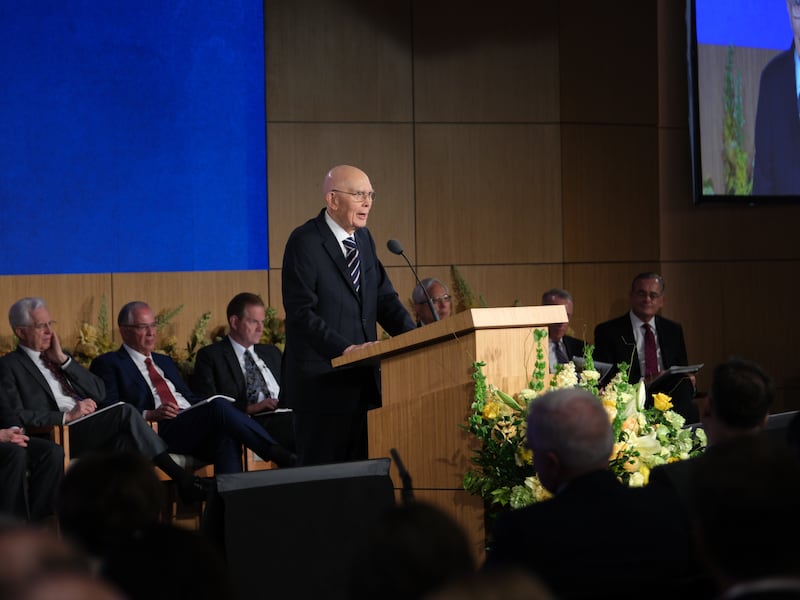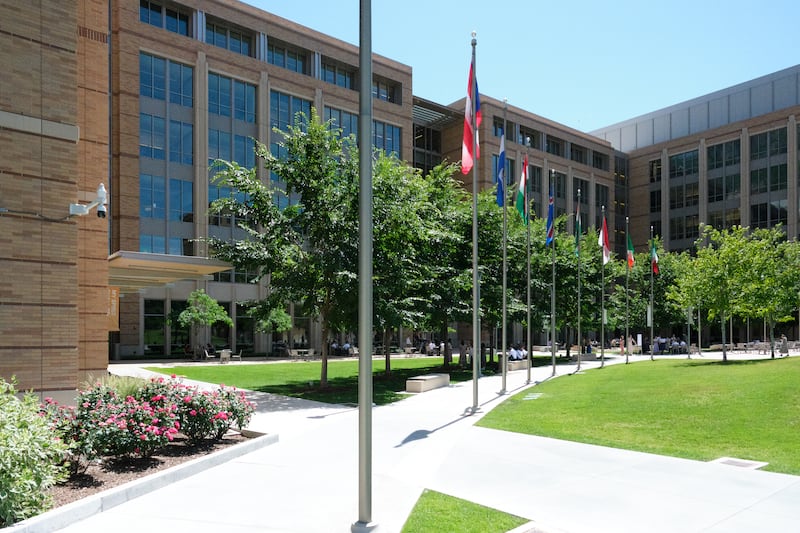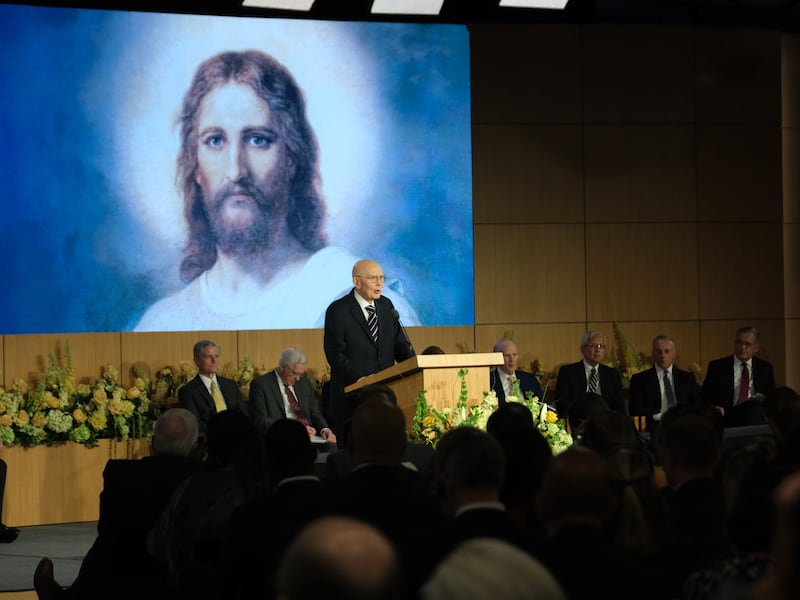PROVO, Utah — As young missionaries have a tendency to use their mission leaders as occupational role models, “there is another role model of far greater significance,” said President Dallin H. Oaks, first counselor in the First Presidency, during the 2024 Seminar for New Mission Leaders.
“Teach your missionaries to study the life of our Lord and Savior Jesus Christ and to make His qualities their role models for mortality and all eternity.”
President Oaks titled his remarks given at the Provo Missionary Training Center on Saturday, June 22, as “Setting Directions for Our Futures.”

Speaking from more than six decades of experience — first as a teacher of law students, then as president of Brigham Young University, and for the last 40 years as a general authority speaking to missionaries and future missionaries — President Oaks shared a few things he has learned in observing and counseling young men and women as they plan for their futures.
He encouraged mission leaders to teach young people to use Jesus Christ as their perfect role model in all aspects of their lives, “especially in loving others and in following His example of Christlike leadership.”
‘Partial’ role models
From talking to young people at BYU and in the mission field, President Oaks said he has learned that many assume they’ll have and begin to prepare for the same occupations as their fathers or mothers.
Even young President Oaks — the oldest of three children — grew up assuming it was expected that he would be a medical doctor like his deceased father. It took only a few weeks into a zoology class at BYU for President Oaks to realize he wanted no part of a medical occupation.
“I dreaded telling my mother that I did not want to be a doctor, but she made it easy for me. She said, ‘You don’t have to be a doctor like your father. You should take different classes at BYU and determine what you are interested in doing. To satisfy me, you just need to find an honest occupation at which you can excel and still have time to serve the Lord.’”
President Oaks pointed out that some missionaries feel drawn toward their mission president’s occupation and assume they should follow that.
“Sometimes these expectations are suitable for the talents and ultimate circumstances of elders and sisters, but sometimes they are not,” President Oaks said. “As mission leaders, you need to anticipate and counteract the tendency for you to become occupational role models for your elders and sisters.”

To dissuade elders and sisters from using them as occupational role models — which are temporary at best — mission leaders can teach their missionaries to make the Savior’s qualities their overall role models for mortality and all eternity.
“What they should want to become is a devoted disciple of Jesus Christ, following His direction to ‘be perfect even as I, or your Father who is in heaven is perfect,’” President Oaks said, quoting 3 Nephi 12:48.
Because perfection is not attainable in mortality, one cannot find and follow “overall” mortal role models. However, there are mortals whose lives embody some qualities of perfection, and they can be “partial” role models for those qualities, President Oaks explained.
For example, in an early period of his life, President Oaks looked to President Spencer W. Kimball as a mortal model for humility. “For me, I could not reasonably aspire to all of his great qualities, but aspiring to one seemed possible,” President Oaks said.
“Similarly, you mission leaders can appropriately seek to be mortal role models in the way you testify and teach of our Savior and Redeemer, Jesus Christ.”
The only ‘overall’ role model
The Savior warned against those who love the “praise of men more than the praise of God” (John 12:43), which warns against choosing even partial role models who pursue worldly ways, President Oaks said.
“The only role model we are safe to follow overall is that of our Savior,” he said.
“His example and His teachings define the path for every disciple of Jesus Christ. … Following Christ is not a casual or occasional commitment but a continuous commitment and way of life that applies at all times and in all places.”
Quoting Jesus’ admonition to “Be ye therefore perfect” (Matthew 5:48), President Oaks said Latter-day Saints know from modern revelation that this commandment to seek perfection is part of Heavenly Father’s plan for the exaltation of His children.

“Disciples of Christ seek to follow Him and become like Him, not only here but also hereafter,” he said, referencing the final verses of the hymn “Come, Follow Me.”
To follow Christ, President Oaks added, “we need to study the scriptures that record what He said and did.”
He quoted then-Elder Russell M. Nelson’s invitation to young adults in 2017 to study everything Jesus said and did as recorded in the standard works and let the scriptural citations about Jesus Christ in the Topical Guide become their “personal core curriculum.”
Love and leadership
President Oaks identified two specific subjects for mission leaders to emphasize as they teach young people to follow and use Jesus Christ as their role model — “a new kind of love” and “a superior kind of leadership.”
At the end of His mortal ministry, Jesus gave His disciples “a new commandment” to “love one another, as I have loved you” (John 13:34). Repeated three times, that commandment was simple but difficult, President Oaks said.
The late President Thomas S. Monson, 16th President of the Church, taught that “love is the very essence of the gospel, and Jesus Christ is our Exemplar. His life was a legacy of love.”
President Oaks said Latter-day Saints are not alone in their determination to follow Jesus and love their neighbors.
Upon accepting a notable award for religious liberty, Monsignor James Shea, a Catholic leader, said: “We are not service providers, we are not philanthropists, we are communities of faith responding in unity to the call of God. …
“We can do much better than tolerance. … [We say to our neighbors,] ‘You are not a problem. You are my brother, my sister, and God put you in my life for a purpose. In darkness and confusion, you can count on me for genuine support and to speak the truth in love.’ … When we are clear about who we are and where we are going, we can foster that civilization of love.”
Those who seek to follow Christ by developing Christlike love must also apply the qualities of Christlike leadership, President Oaks said.
He reiterated some of his teachings to Area Seventies in 2014 about becoming Christlike leaders, which he said apply directly to mission leaders’ and missionaries’ efforts to follow the Savior along the path to perfection.
“Love is the first principle of leadership,” President Oaks said. “Its effect magnifies the effects of every other principle of leadership. Leaders who love those that they lead enhance the impact of their leadership and the duration of their influence.
“A Christlike leader should teach the flock that they should always look toward the Master. One who teaches this to the flock should never obscure their view by standing in the way, such as by seeking the limelight himself or by casting a shadow of self-interest, self-promotion or self-gratification.”
Christlike leaders should be humble and obedient, and they should have understanding and compassion for those they lead, President Oaks continued. They should seek to teach like the Savior, using simple language with stories and examples that make sense to those who are being taught.
“The Savior led by example. No single principle of leadership is more powerful in its effect on followers than a leader setting the right example, and Jesus did that. In the conclusion of His direct teachings on this continent, He said, ‘Therefore, what manner of men ought ye to be? Verily I say unto you, even as I am’ (3 Nephi 27:27).”
President Oaks concluded by telling mission leaders they are encouraged and strengthened in their efforts to teach young people to use Jesus Christ as their role model and to follow President Nelson’s teachings to keep their covenants and worship in the temple as often as possible.
“I testify of Jesus Christ, whose servants we are and whose love and leadership attributes we seek to emulate,” President Oaks said.



